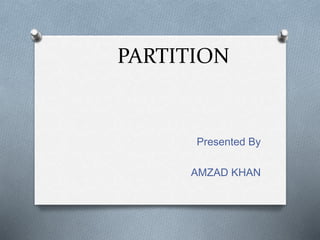
HDD Partition
- 2. What Is a Partition? O The partitioning of a hard drive occurs after the drive has been physically formatted but before it is logically formatted. It involves creating areas on the disk where data will not be mixed O example, to install different operating systems that do not use the same file system. Therefore, logically there will be at least as many partitions as there are operating systems using different file systems. If you are using just one operating system, a single partition of the full size of the disk is sufficient. That is unless you want to create several partitions so as to have several drives on which data is kept separately.
- 3. O There are three types of partitions: primary partitions, extended partitions and logical drives. A disk may contain up to four primary partitions (only one of which can be active), or three primary partitions and one extended partition. In the extended partition, the user can create logical drives
- 4. Primary Partition O A primary partition is in which an Operating System can be installed. One MBR hard disk may contain a maximum of 4 primary partitions. An active partition is based on primary partition. Any one of the 4 primary partitions can be set as active partition. Since there can be 4 primary partitions with 4 different Operating Systems installed, one of the partition that is marked active is used for the initial booting. The active partition contains the boot loader (such as ntldr or bootmgr) to load operating systems from a disk.
- 5. Active Partition O The active partition is the partition where the boot flag is set. DOS and Windows allow only one boot partition to be set with the boot flag.
- 6. Extended Partition O An HDD may contain only one extended partition, but that extended partition can be subdivided into multiple logical partitions. DOS/Windows systems may then assign a unique drive letter to each logical partition.
- 7. Logical Drive O Also called logical partition. A volume created within an extended partition on a basic disk. A logical drive can be formatted and assigned a drive letter, but cannot host an operating system.
- 8. What is Partition Table? O Partition Table is a storage space which records some information about primary, extended and logical partitions. Further, the create/delete/resize of any partition all will modify the partition table to reflect the changes permanently. If partition table is crashed by virus or other stuffs, you partition will lost, so the table is extremely important.
- 9. MBR O Master boot record is the information present in the first sector of any hard disk. It contains the information regarding how and where the Operating system is located in the hard disk so that it can be booted in the RAM. O MBR is sometimes called master partition table because it includes a partition table which locates every partition in the hard disk. O Master boot record (MBR) also includes a program which reads the boot sector record of the partition that contains operating system.
- 10. GPT O (GUID Partition Table) The format used to define the hard disk partitions in computers with UEFI startup firmware. The GUID Partition Table (GPT) replaces the previous master boot record (MBR) method. While the MBR supported partitions as large as 2.2TB, GPT partitions can be up to 18 exabytes. GPT supports a "protective" MBR so that third-party MBR utilities can identify the disk correctly, as well as a "legacy" MBR if the first partition must boot as an MBR drive.
- 11. MBR Vs GPT
